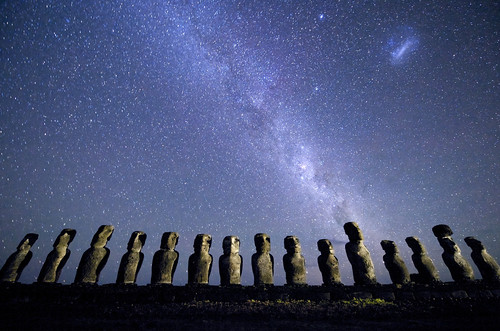It’s a question that’s bamboozled archaeologists for centuries – just where did the Moai of Easter Island get those big red hats? The answer, two British experts have claimed this week, is one of sacred quarries, iconic top-knots and volcanic highways. Sounds a bit too far-fetched for reality? Bear in mind these are the thousand-plus statues which line the world’s remotest inhabited island, in a corner of Polynesia not even touched by Europeans until the eighteenth century, and the truth may seem a little easier to stomach.
The University of Manchester’s Colin Richards and Sue Hamilton from University College London are the first British archaeologists to explore Rapa Nui – to give the island its indigenous name – since 1914. Yet the pair believe they’ve finally solved the mystery of the Moai‘s mottled headgear, with the discovery of a road emanating from an ancient volcano. The road, which Richards claims was made from cemented red scoria dust, leads to a ‘sacred’ quarry where the hats were made. The team have also found an ‘adze’, an ancient axe used to sculpt the monolithic mitres, buried at the quarry. They believe it was deliberately left as an offering to the gods.
“We know the hats were rolled along the road made from a cement of compressed red scoria dust,” says Dr Richards. “We can see they were carefully placed. The closer you get to the volcano, the greater the number. It’s like a church; you can’t just walk straight to the altar. The Polynesians saw the landscape as a living thing, and after they carved the rock the spirits entered the statues.”
The group’s findings may revolutionise the way we understand some of Earth’s most amazing treasures – yet one aspect of the giant hats remains a condundrum: why? There is little in the way of physical evidence, but experts feel the answer may be lie in their rarity. Only 70-75 of the thousand Moai wear the hats, which has led many to believe them to be ancient status symbols. Some even claim they resemble the ancient top-knots or plaits worn by the island’s earliest rulers. “Chieftain society was highly comp etitive and it has been suggested that they were competing so much that they over-ran their resources,” says Dr Hamilton.
etitive and it has been suggested that they were competing so much that they over-ran their resources,” says Dr Hamilton.
The Easter Islanders were known for their fierce in-fighting, and continuous battles took their toll on the island’s tiny population. The first European to visit the island (on Easter Sunday, hence the name) was Dutch explorer Jacob Roggeveen. Since then the islanders have been hit by warring, slave-trading, annexation and disease – which at one point during the late nineteenth century saw its dwindling numbers facing extinction. Not content with his latest coup, Dr Richards hopes to date the Moai successfully over the next five years, as part of the Rapa Nui Landscapes of Construction Project. “We will look to date the earliest statues,” he says. “Potentially this could rewrite Polynesian history.”